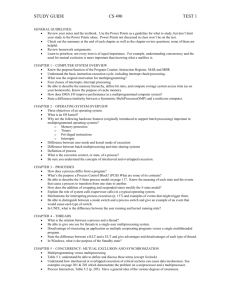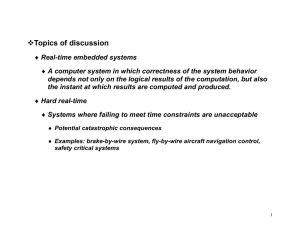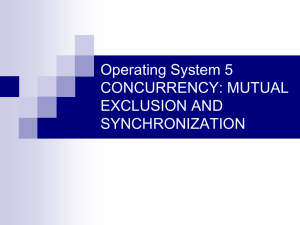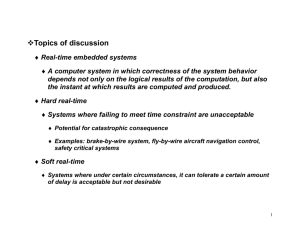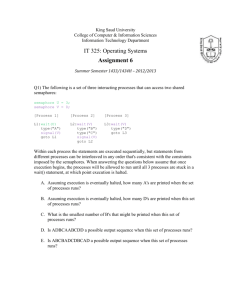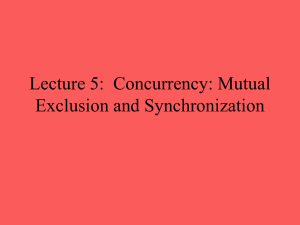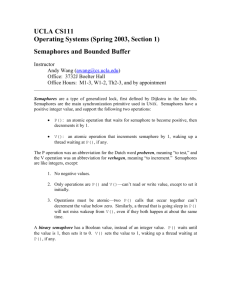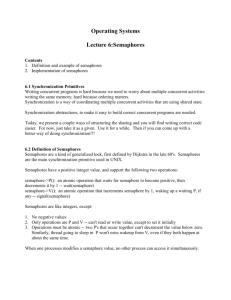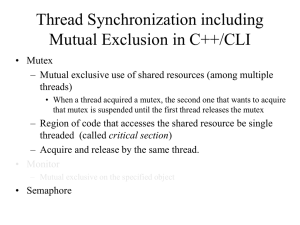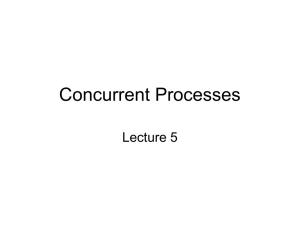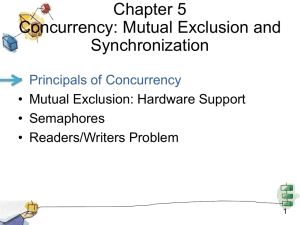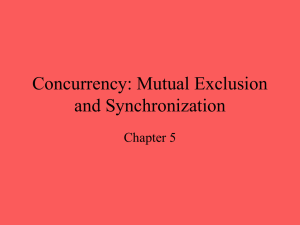Introduction and Synchronization Mechanisms (Chapters 1&2)
advertisement
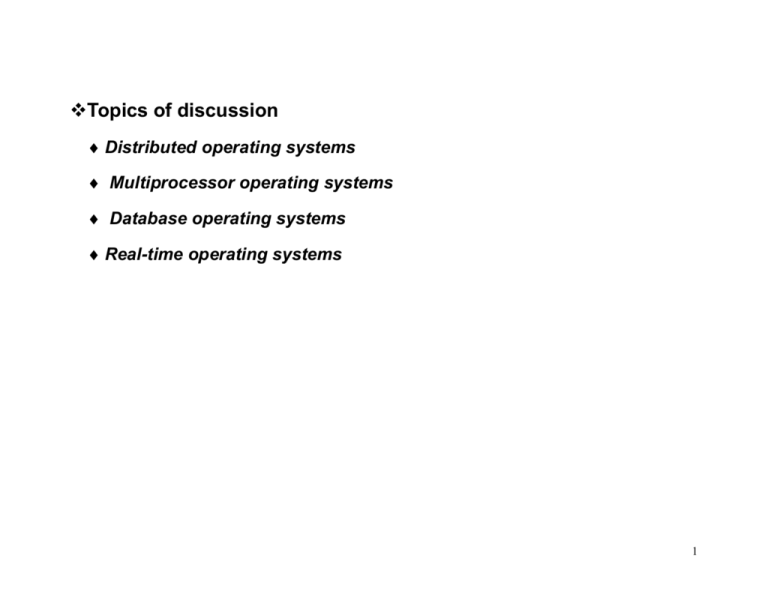
Topics of discussion
Distributed operating systems
Multiprocessor operating systems
Database operating systems
Real-time operating systems
1
Synchronization Mechanisms
2
Process
A process can be though of as a program whose execution has started
and not yet terminated.
A process can be in three states:
Running: The process is using a processor to execute instructions.
Ready: The process is executable, but other processes are executing and all
processors are currently in use.
Blocked: The process is waiting for an event to occur.
Each process uses a Process Control Block (PCB) data structure to
store complete information about the process. PCB contains the
following information:
Process name and id, processor state (program counter, register contents,
interrupt masks, etc.), process state, priority, privileges, virtual memory
address translation maps, information about other resources owned by the
process, etc.
3
Concurrent Processes
Two processes are concurrent if their execution can overlap in time.
In multiprocessor systems, concurrent processes can use different CPUs at
the same time.
In single processing systems, concurrent processing can be thought of as
one process using the CPU while another process uses system I/O, etc. If a
CPU interleaves the execution of several processes, logical concurrency is
obtained.
Processes are serial if the execution of one must be complete before the
execution of the other can start.
Concurrent processes interact using the following mechanisms:
Shared variables.
Message passing.
4
Threads
Threads are mini processes within a process and therefore share the
address space with the processes.
Every process has at least one thread.
A thread executes a portion of the program and cooperates with other
threads concurrently executing within the same process and address
space.
Because threads share the same address space, it is more efficient to
perform a context switch between two threads of the same process
than it is to perform a context switch between two separate processes.
Each thread has it’s own program counter and control block.
5
Critical Sections
In multiprocessing systems, processes or threads may compete with
each other for system resources that can only be used exclusively.
CPU is a good example of this type of resource as only one process or thread
can execute instructions on a single CPU at a time.
Processes may also cooperate with each other by using shared
memory or message passing.
For both of these cases, mutual exclusion is necessary to insure that
only one process or thread at one time holds a resource or modify
shared memory.
A critical section is a code segment in a process in which some shared
resource is accessed.
6
A solution to the mutual exclusion problem must satisfy the following
requirements:
Only one process can execute its critical section at any one time.
When no process is executing in its critical section, any process that requests
entry to its critical section must be permitted to enter without delay.
When two or more processes compete to enter their respective critical sections,
the selection cannot be postponed indefinitely (Deadlock).
No process can prevent any other process from entering its critical section
indefinitely (Starvation).
7
Some Mechanisms for Insuring Mutual Exclusion
Polling or Busy waiting
Disabling interrupts
Semaphores
8
Semaphores
A semaphore is an integer variable S and an associated group of
waiting processes for which only two operations may be performed:
Wait state P(S): if S 1 then S := S – 1
else the executing process waiting for the semaphore S joins the wait queue for S and
forfeits the resource;
endif
Signal state V(S): if wait queue for S is not empty then remove a process from the queue
and give it the resource
else S := S + 1
endif
9
A semaphore can be used for synchronization and mutual exclusion.
Synchronization: Coordination of various tasks or processes.
Mutual exclusion: Protection of one or more resources or implementation of
critical sections among several competing processes sharing the critical
section.
There are three types of semaphores:
Binary semaphores
Mutual exclusion semaphores (mutex)
Counting semaphores
10
Binary Semaphores
Simplest form of the semaphore.
Primarily used for synchronization. Can also be used for mutual exclusion.
Using a binary semaphore, a process can wait (block or pend) on an event
which triggers the release of a semaphore.
Should be used in place of polling.
- Polling is an inefficient way of synchronization or event waiting because of the use of processor
resources.
- Using semaphores, the process is in a blocked or pended state while other processes use the
processor.
- Upon the occurrence of the event, the pended process becomes ready to execute.
11
Mutual Exclusion Semaphores
Used to provide resource consistency in a system for resources shared
simultaneously by multiple tasks.
- Shared resources can be such as shared data, files, hardware, devices, etc.
To protect against inconsistency in a multi-tasking system, each task must
obtain exclusive access right to a shared resource.
12
One common problem that can occur without designing proper mutual
exclusion in a multi-tasking system sharing resources simultaneously is
known as the “Racing condition”.
- Based on which task gets to the resource first the system behavior is different.
- Racing conditions can go on undetected for a very long time in a system and can be a very
difficult problem to detect and fix.
When using mutual exclusion semaphores, be aware of the racing
condition; deadlock.
- Use only one mutual exclusion semaphore to protect resources that are used together.
When using mutual exclusion semaphores, avoid starvation situations.
- Do not include unnecessary sections in the critical section.
Mutual exclusion semaphores can not be used in interrupt service routines.
13
Counting Semaphores
Yet another mean to implement task synchronization and mutual exclusion.
Counting semaphore is just like the binary semaphore with the exception
that it keeps track of the number of times a semaphore has been given or
taken.
- Counting semaphores use a counter to keep track of the semaphores and hence the name,
counting semaphore!
- The semaphore is created with a fixed number of semaphores available.
- Every time that a semaphore is taken, the semaphores count is decremented.
- When a semaphore is given back, if a task is blocked on the semaphore, it takes the semaphore.
Otherwise, the semaphores count is incremented.
Counting semaphores are generally used to guard resources with multiple
instances.
14
Classical Synchronization Problems
The dining philosophers problem
The producer-consumer problem
The readers-writes problem
Reader’s priority
Writer’s priority
15
Language Mechanisms for Synchronization
Monitors
Used in multiprogramming environment.
Abstract data types for defining/accessing shared resources.
Consists of procedures, shared resource, and other data.
- Procedures are the gateway to the shared resource and are called by the processes needing
to access the resource.
Only one process can be active within the monitor at a time. Processes trying
to enter the monitor are placed in the monitor’s entry queue.
Procedures of a monitor can only access data local to the monitor.
Variables/data local to a monitor cannot be directly accessed from outside the
monitor.
16
Synchronization of processes is accomplished via two special
operations, ”wait” and “signal”, executed within the monitor’s
procedures.
Execution of a wait operation suspends the caller process and the caller
process relinquishes control of the monitor.
-
<condition variable>.wait
When a waiting process is signaled, it starts execution from the very next
statement following the wait statement.
-
<condition variable>.signal
Waiting processes are placed on queues (priority or standard).
-
<condition variable>.queue returns true if the queue associated with the condition variable is
not empty.
Monitor solution for the reader’s priority problem.
17
readers-writes: monitor;
begin
readercount : integer;
busy : boolean;
Oktoread, Oktowrite : condition;
procedure startread;
begin
if busy then Oktoread.wait;
readercount := readercount +1;
Oktoread.signal; { once one reader can start reading, then they all can }
end startread;
procedure endread;
begin
readercount := readercount -1;
if readercount = 0 then Oktowrite.signal;
end endread;
procedure startwrite;
begin
if busy OR readercout 0 then Oktowrite.wait;
busy := true;
end startwrite;
procedure endwrite;
begin
busy := false;
if Oktoread.queue then Oktoread.signal { reader gets priority over writer hence reader’s-priority solution }
else Oktowrite.signal;
end endwrite;
18
begin { Initialization }
readercount :=0;
busy := false;
end;
end readers-writers;
19
Serializers
Used in multiprogramming environment.
Abstract data types defined by a set of procedures.
Can encapsulate the shared resource.
Only one process has access to the serializer at a time.
However, procedures of a serializer may have hollow regions wherein
multiple processes can be concurrently active. When a process enters a
hollow region, it releases the possession of the serializer.
- join-crowd (<crowd>) then <body> end
- leave-crowd (<crowd>)
Uses “queues” along with a condition to provide synchronization (delay or
block).
- enqueue (<priority>, <queue-name>) until (<condition>)
20
readerwrite: serializer
var
readq: queue;
writeq: queue;
rcrowd: crowd; { readers crowd }
wcrowd: crowd; { writers crowd }
db: database; { the shared resource }
procedure read (k:key, var data: datatype)
begin
enqueue (readq) until empty(wcrowd);
joincrowd (rcrowd) then
data := read-open(db[key]);
end
return (data)
end read;
procedure write (k:key, data:datatype);
begin
enqueue (writeq) until
(empty(wcrowd) AND empty(rcrowd) AND empty(readq));
joincrowd (wcrowd) then
write-opn (db[key], data);
end
21
end write;
22
Communicating Sequential Processing (CSP)
Processes interact by means of input-output commands (based on
message passing not shared memory).
Communication:
An input command in one process specifies the name of another process as
its source
An output command in the other process specifies the name of the first
process as its destination
23
Processes are synchronized by delaying an input (output) command in
one process until a matching output (input) command is executed by
another process.
Commands are not buffered
Guarded Commands:
G CL
“G” is referred to as a guard and is a Boolean expression
CL is a list of commands
The command list is executed only if the corresponding guard is evaluated as
true. Otherwise the guarded command fails.
An input command can be placed in a guard. In such situation, the guard is
not true until the corresponding output command has been executed by some
other process.
24
Alternative Commands:
G1 CL1 G2 CL2 G3 CL3 … Gn CLn
Specifies execution of one of its constituent guarded commands.
Repetitive Commands:
* [G1 CL1 G2 CL2 G3 CL3 … Gn CLn ]
Specifies repeated executions of its alternative commands until the guards of
all guarded commands fail.
Producer-Consumer problem
25
Ada Concurrent Programming Mechanisms
Ada Packages
Package is the fundamental program building block
Package Specification
package Name is
Declaration of visible procedures (headers only), necessary types,
constants, and variables.
end;
Package Body
package body Name is
Declaration of local procedures, types, constants, and variables.
begin
Initialization statements to execute for each instantiation.
end;
26
Ada Tasks
Task is a process
Task Specification
task [type] Name is
entry specifications
end;
Task Body
task body Name is
Declaration of local procedures, types, constants, and variables.
begin
Statements of the task.
exception
Exception handlers for this task.
end;
27
An entry specification has the same syntactic structure as the header of a
procedure.
Corresponding to an entry is one or more accept statements in the executable
part of the task body.
accept Entryname (formal parameters) do
Statements forming the body of the entry
end Entryname;
A task entry, E of a task T is called in other tasks with the form:
T.E (parameters)
accept statement executes when normal processing reaches it and another
task executes a corresponding entry call statement.
This is a synchronization method known as Ada Rendezvous and is similar to
Remote Procedure Call (RPC).
Ada offers Select statement for asynchronous & nondeterministic processing.
28
Path Expressions
A path expression restricts the set of admissible execution histories of
the operations on the shared resource so that no incorrect state is ever
reached
It indicates the order in which operations on a shared resource can be
interleaved
The general form of a path expression follows:
path <exp> end;
<exp> denotes possible execution histories with the following
possible opperators:
29
Sequencing: x;y
Synchronizes the beginning of y with the completion of x
Selection: (<exp> + <exp> + … + <exp>)
in some literature: ( <exp>,…, <exp>)
Only one of the operations connected by + can be executed at a time
Concurrency: { }
Any number of instances of the operation delimited can be in execution at a
time
Weak reader’s priority solution:
path {read} + write end
Writer’s priority solution:
path start-read + {start-write ; write} end
path { start-read ; read} + write end
30
Axiomatic Verification of Parallel Programs
Helps us prove various properties about a parallel program
Gives us intuitive guidance concerning the development of correct
parallel programs
31
The language
Cobegin statement
Source r1 (variable list), . . . , rm (variable list):
cobegin S1 || S2 || . . . || Sn coend
Resource ri is a set of shared variables
S1, S2, . . . , Sn are statements called processes to be executed in parallel
With-when statement ( critical section statement )
with r when B do S
Reduces the problems caused by concurrent access to shared variables by
ensuring that only one process will access the variables in a resource at a
time
32
The Axioms
Invariant for a resource r, I( r ) describes acceptable states of the
resource
I( r ) must be true before the execution of parallel program begins and
must remain true during its execution except when the critical section for r is
being executed
Parallel Execution Axiom
If {P1} S1 {Q1}, . . . , {Pn} Sn {Qn}, no variable free in Pi or Qi is
changed in Sj (ij), and all variables in I( r ) belong to resource r,
then
{P1 P2 . . . Pn I( r )}
resource r: cobegin S1 || S2 || . . . || Sn coend
{Q1 Q2 . . . Qn I( r ) }
Critical Section Axiom
If {I( r ) P B} S { I( r ) Q} and I( r) is the invariant of the
cobegin statement for which S is a process, and no variable free in P
and Q is changed in any other process, then
33
{P} with r when B do S{Q}
34
